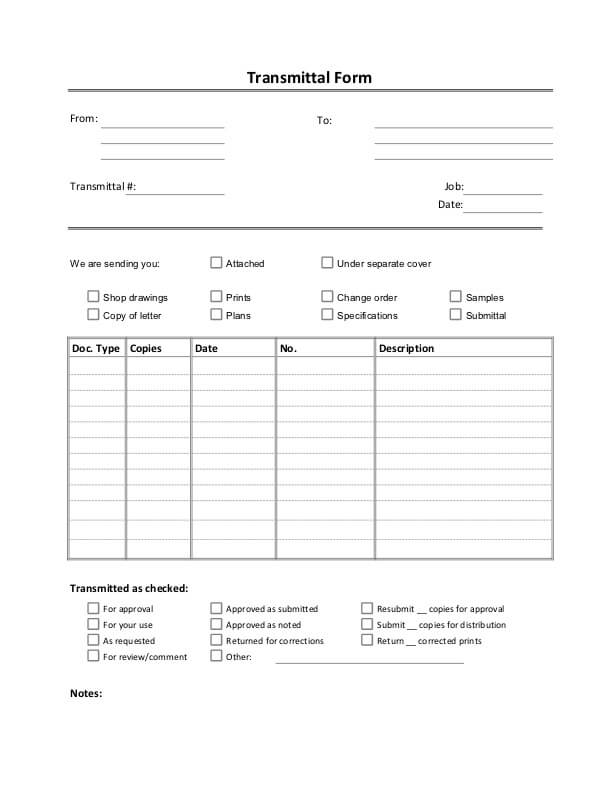
On a construction project, transmittals provide specific proof of what was sent, who it was sent to, and when it was sent. They help document the flow of information during a project. We’ll discuss more about what they are, why they’re important, and how they may help you get paid faster.
There are a lot of documents, files, and samples that change hands during a construction project. Keeping track of when they were distributed and to whom is imperative. The success of claims and lawsuits often hinges on who knew what and when, so having proof that documents or files were sent can help win your case.
What is a transmittal?
A transmittal, also called a letter of transmittal, is a document that is sent along with other documents, files, or samples. It shows when the items were sent and provides proof that they were sent.
These documents can be particularly important on a construction project, as they document when project documents were sent and who they were sent to. They are often used as evidence in the event of a claim or lawsuit.
Free transmittal form template

Download a free template for a Letter of Transmittal for use on any construction project
How transmittals are used in construction
Transmittals are used to keep detailed records of information sent from one party to another. On construction projects, it’s important to know when information, like revised a plan, was distributed and who received it. Transmittals provide that documentation and detail the information needed to prove delivery.
In these days of email correspondence, transmittals are not as popular as they once were. Many documents and other project information are sent out informally through email, and the record of the email is often sufficient.
However, important documents like contracts, submittals, samples, notices, and plans, should have a letter of transmittal included to show when and where the documents were sent.
How to Write a Letter of Transmittal
When it comes time to write a transmittal, there’s important information that must be present for the benefit of both the recipient and sender. Letters should be clear and concise to reduce confusion and ensure that every item is accounted for.
Begin the letter with an introduction of general information and sender/recipient details, this includes:
- Date sent
- Contact information
- Company names and addresses
- Project name
- Transmittal number
The body indicates the purpose of the transmittal and gives context for the attached documents or items. Describe any important details of the documents, and give an explanation for why they are being sent. The recipient must be clear on the reason for the transmittal, so that they may respond or act accordingly.
Clarify for the receiver any actions that must be taken after getting the letter. Request for confirmation or a follow-up to gather more information. Indicate what needs to be done with the attached items, if signatures are required or if it needs to be reviewed.
Make sure to include a date for when any required actions are due by.
After providing a detailed list of all attached items, sign out the letter with any other contact information that may be relevant.
Sending transmittals
Since a transmittal is typically sent along with other documents or materials, it can be sent in any format that accompanies the attachments. The information from a letter of transmittal could also be included in the body of an email when documents are attached, to make it easy to search for the records.
Software
There are lots of software packages you can use to create, send, and track letters of transmittal. Almost any construction project management software, such as Jonas, eSub, and Procore, includes transmittals as one of their tools.
Templates
If you aren’t currently using project management software but want to start using transmittals for your projects, you can use a free Transmittal Form template.
You can also create your own transmittal template easily in a Word document or Excel file. There are no laws that say what must be included in a transmittal. What’s most important is that it contains the information that you — and the party receiving it — need for record-keeping.
Transmittals vs submittals
The main purpose of a transmittal is to document the sending of documents, files, or samples. If the documents are distributed by hand, the sender can request the receiver sign the transmittal as proof of delivery. If the documents are sent electronically or through the mail, a separate proof of delivery will be needed.
Submittals generally consist of product information and samples that are submitted to the design team for approval before any materials are purchased and installed on the project. They are usually composed of product data sheets, brochures, SDS, product samples, or color charts.
The design team is expected to review these documents for adherence to the project specifications. Once the documents or samples are reviewed, then they are returned to the contractor for purchase and installation. This helps ensure that the materials used on the project meet the designer’s intent.
A transmittal may accompany a submittal in order to document that it has been sent, and as a way to request a review of the submittal. In fact, the document may be titled “Submittal Transmittal.”
Instructions about what type of review needs to be made, or if a selection is required, help the design team know what they’re expected to do with the documents or samples.
Why transmittals matter: Getting paid
“He with the most documents, wins,” is a well-known maxim in construction. Documentation of when parties were sent certain documents, or informed of changes, can be important when it comes to claims and lawsuits. Having the most accurate documentation is a necessity if you want to win.

Watch & Learn
How organized documentation can save you in a dispute (Webinar)
There are a lot of documents and communications sent during a project, especially a large commercial project. There may be hundreds of submittals, RFIs, and drawings that need to be distributed and organized. Having a clear record of when they were sent out, and to whom, can make all the difference when a conflict arises.
Conflict about who knew what and when can delay payments on any project. Having a clear paper trail makes it easier to prove when information was sent and who received it. Emails often get lost or accidentally deleted, so the more permanent records you have, the better.
Like any other project document, make sure your transmittals are stored securely and are included with other project records. Use them when sending important documents, files, drawings, or samples. If you need them later to prove that you sent information, they’ll be able to provide the specific proof you need.
